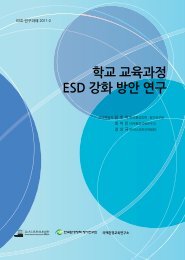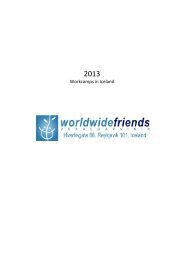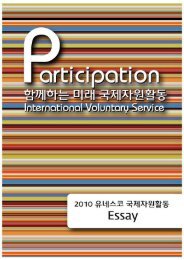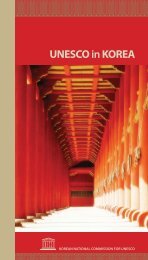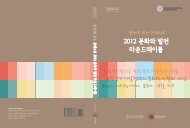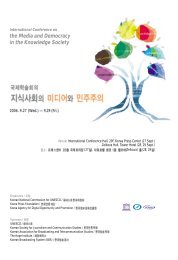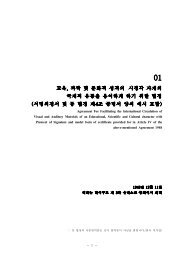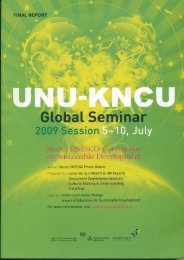DMZ ì¼ì ìí ííì ê´ë¦¬ë¥¼ ìí êµì 컨í¼ë°ì¤ - ì ë¤ì¤ì½íêµììí
DMZ ì¼ì ìí ííì ê´ë¦¬ë¥¼ ìí êµì 컨í¼ë°ì¤ - ì ë¤ì¤ì½íêµììí
DMZ ì¼ì ìí ííì ê´ë¦¬ë¥¼ ìí êµì 컨í¼ë°ì¤ - ì ë¤ì¤ì½íêµììí
Create successful ePaper yourself
Turn your PDF publications into a flip-book with our unique Google optimized e-Paper software.
<strong>DMZ</strong> 일원 생태ㆍ평화적 관리를 위한 국제컨퍼런스<br />
of the local people in the three parts of the Rhön. Although the Rhön is not a transboundary<br />
biosphere reserve in the strict sense as it does not extend beyond an international border, it<br />
shares a lot of characteristics of a transboundary region due to the federal structure of<br />
Germany, where the individual Länder (provinces) have far reaching jurisdictions and a<br />
freedom of scope in their legal, organisational and political arrangements.<br />
In this context close co-operation is key, and the three decentralized Rhön biosphere<br />
reserve administration units play an active role as facilitators. This relates equally to the<br />
cooperation with and between public agencies and administrations, municipalities and districts,<br />
NGOs and the private sector.<br />
The presentation outlinesthe strategies and mechanisms to make a biosphere reserve work<br />
beyond administrative boundaries. Based on the practical experience from the trilateral Rhön<br />
biosphere reserve and backed by the experience of other transboundary biosphere reserves<br />
(UNESCO 2000), a number of recommendations could be made, which may apply to other<br />
regions, who intend a co-operation beyond administrative boundaries (e.g. in a transboundary<br />
context). In a step by step approach can be recommended to<br />
• identify local and national partners of a transboundary work group in order to define<br />
strengths and weaknesses, threats and potentials of the respective region and define those<br />
issues which are of transboundary importance for co-operation.<br />
• set up a co-ordinating steering group, representing various administrations and sciences as<br />
well as the authorities in charge, representatives of local communities, interested and<br />
affected groups, including youth, and of the private sector and (regional)<br />
non-governmental organisations<br />
• work out and agree upon common visions and goals for the region in a transboundary<br />
context<br />
• work out a planning concept, linking goals and functions to space (e.g. considering<br />
development and protection needs, considering trade-offs and balance amongst ecosystem<br />
services, human environment interactions and wellbeing). For example, UNESCO<br />
biosphere reserves follow an integrated zoning pattern which has been defined according<br />
to the Statutory Framework of UNESCO and consists of one (or more) protected core<br />
areas, of surrounding buffer zones, embedded in an transition area. To each of the zones<br />
multiple functions may be allocated (MAB 2008).<br />
• define transboundary joint projects<br />
• implement a coordinative focal point in each part of the respective region<br />
• set up a (lean) transboundary coordination mechanism to ensure that joint projects can be<br />
put in place, yet respecting and ensuring the countries'/provinces' full independence. This<br />
could be e.g. a permanent secretariat jointly financed by the member countries or it<br />
38 ❙ <strong>DMZ</strong> 일원의 생태⋅평화⋅지역발전



